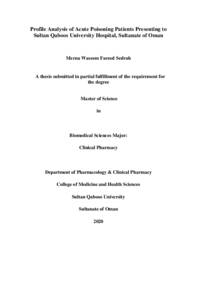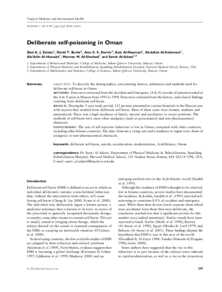Document
Profile analysis of acute poisoning patients presenting to Sultan Qaboos University Hospital, Sultanate of Oman.
Identifier
Sedrah, Merna Waseem Fareed (2020). Profile analysis of acute poisoning patients presenting to Sultan Qaboos University Hospital, Sultanate of Oman (Master thesis, Sultan Qaboos University, Muscat, Oman).
Publisher
Sultan Qaboos University.
Gregorian
2020
Language
English
English abstract
Background
Acute poisoning remains a significant paramount clinical emergency globally. The type of
poison to which an individual is exposed to varies all over the world and may even vary in
different regions of the same country depending on the socioeconomic factors and cultural
diversity. It is of a crucial importance to investigate and analyze the pattern and severity of
poisoning in order to manage poisoning cases. Accordingly, prompt initiation of appropriate
emergency care and supportive measures could be life-saving and could possibly reduce
morbidity and mortality.
Aim
To characterize acute poisoning, marine envenomation, venomous animal bites/stings, identify
the outcome of poisonings and analyze the pattern of management of acute poisoning cases
presenting to the emergency medical department in Sultan Qaboos University hospital (SQUH)
in the Emergency Medical Department (EMD).
Objectives
To analyze reported acute poisoning cases by EMD at SQUH for demographical information
and etiological patterns and to identify the nature of agents involved in acute poisoning.
To determine risk factors of prolonged hospital stay for acute poisoning cases.
To assess the adherence to the National Management Guidelines of Poisoning by Ministry of
Health (MOH).
Methods
This was a retrospective study done in the EMD of SQUH (a tertiary care hospital). The Study
included a total of 350 cases, out of which 336 patients of acute poisoning, 10 cases of marine
envenomation and 4 cases of venomous animal bites/stings. Data regarding demographics,
type, and mode of poisoning, comorbid illness, complications, system involvement, first aid
outside SQUH, initial treatment at the hospital, requirement of antidote, duration of
hospitalization, and outcome were obtained.
vi
Scoring system: Ministry of health of Oman (MOH) poisoning scoring system, that was adapted
from "Poisoning Severity Score" (PSS). It is a standardized scale for grading the severity of
poisoning to facilitate qualitative evaluation of morbidity due to poisoning, better identification
of real risks and comparability of data. As per MOH poisoning scoring system, severity
grading is classified to minor, moderate, and severe/fatal.
Results
Among the 350 patients included, females accounted for the majority of cases (56,3% versus
43.7%). Intentional exposures were seen more frequent (186, 53.1%). Most of the reported
poisoning cases were due to medicinal drugs exposures (247, 71%). Among medicinal drug
poisonings, multiple drugs intake was prominent (56, 16%), while among non-pharmaceutical
exposures, household products were common (57, 16.4%).
It was found that (67 ,19.1%) were treated conservatively without receiving any medical
intervention. Length of hospitalization was the highest in patients who were admitted to
psychiatry medicine and/ or Intensive care unit (ICU), those who developed multiple system
manifestations and among those who received antidotes.
There was one death (case fatality rate of 0.3), primarily from organophosphate pesticide
ingestion
Conclusion
Poisoning in the age group of ≤ 12 years is mainly unintentional and commonly due to
pharmaceutical agents while poisoning in older age groups is mainly intentional (self-harm).
Opioids were detected to cause high rates of delayed recoveries, whereas hydrocarbons, mainly
toluene was the most frequent non-pharmaceutical agent causing delayed recovery. Drugs
detected at high rates in poisonings, such as paracetamol should be used more cautiously.
Member of
Resource URL
Arabic abstract
الخلفية
لا يزال التسمم الحاد يمثل حالة طوارئ سريرية كبيرة علي مستوي العالم، يشهد نوع السموم المستهلكة اختلافا هامشيا نع جميع انحاء العالم و قد يختلف في مناطق مختلفة من نفس البلد اعتمادا علي العوامل الخارجية الاقتصادية و التنوع الثقافي. و بالتالي فان تقييم و تحليل حالات التسمم يمثل اهميه كبري في ادارة حالات التسمم و بناء علي ذلك فان البدء الفوري في رعاية الطوارئ المناسبة و التدابير الوقائية الداعمة يمكن ان تنقذ الحياة و تقلل من المرض و الوفيات.
الهدف: توصيف حالات التسمم الحاد، التعويض البحري و لدغات/لسعات الحيوانات السامة، تقييم ادارة و تحليل النتائج الناتجة من حالات التسمم الحادة المقدمة الي قسم الطوارئ الطبية في مستشفي جامعة السلطان قابوس
الأهداف
تحليل حالات التسمم التابعة لمستشفي جامعة السلطان قابوس للحصول علي البيانات الديموغرافية و العوامل المسببة للتسمم
التعرف علي طبيعة (نوع) المواد المسببة للتسمم
تحديد العوامل الاكلينيكية وعوامل الخطر التي تحدد مدة الاقامة الطويلة داخل المستشفى
تحديد النتائج الاكلينيكية المرتبطة بعلاج حالات التسمم
تقييم كيفية ادارة حالات التسمم بالاضافة الي تقييم مدي التزام الطاقم الطبي المسئول عن علاج حالات التسمم للقواعد الارشادية الوطنية
الطريقة
دراسة رصدية استراجعية للمرضي الحاضرين الي مستشفي جامعة السلطان قابوس في قسم الطوارئ. الدراسة شملت ??? مريض، منهم ??? مرضي بحالت التسمم الحاد، ?? حالات ناتجة من تسمم الكائنات البحرية، ? حالات ناتجة من حيوانات سامة. البيانات الديموغرافية، النوع، وسيلة التسمم، الامراض المدمنة، المضاعفات، اجهزة الجسم المصاحبة، الاسعافات الاولية التي تلقاها المريض خارج المستشفي، الاجراءات العلاجية داخل المستشفي، مضادات التسمم ، مدة الاقامة داخل المستشفي التي تم الحصول عليها .درجة خطورة الحالة: تم الاعتماد علي نظام درجات وزارة الصحة و المقتبسة من مقياس شدة التسمم و هو يعتبر نظام قياس موحد لحدة التسمم يسهل التقييم النوعي لخطورة حالات التسمم
لا يزال التسمم الحاد يمثل حالة طوارئ سريرية كبيرة علي مستوي العالم، يشهد نوع السموم المستهلكة اختلافا هامشيا نع جميع انحاء العالم و قد يختلف في مناطق مختلفة من نفس البلد اعتمادا علي العوامل الخارجية الاقتصادية و التنوع الثقافي. و بالتالي فان تقييم و تحليل حالات التسمم يمثل اهميه كبري في ادارة حالات التسمم و بناء علي ذلك فان البدء الفوري في رعاية الطوارئ المناسبة و التدابير الوقائية الداعمة يمكن ان تنقذ الحياة و تقلل من المرض و الوفيات.
الهدف: توصيف حالات التسمم الحاد، التعويض البحري و لدغات/لسعات الحيوانات السامة، تقييم ادارة و تحليل النتائج الناتجة من حالات التسمم الحادة المقدمة الي قسم الطوارئ الطبية في مستشفي جامعة السلطان قابوس
الأهداف
تحليل حالات التسمم التابعة لمستشفي جامعة السلطان قابوس للحصول علي البيانات الديموغرافية و العوامل المسببة للتسمم
التعرف علي طبيعة (نوع) المواد المسببة للتسمم
تحديد العوامل الاكلينيكية وعوامل الخطر التي تحدد مدة الاقامة الطويلة داخل المستشفى
تحديد النتائج الاكلينيكية المرتبطة بعلاج حالات التسمم
تقييم كيفية ادارة حالات التسمم بالاضافة الي تقييم مدي التزام الطاقم الطبي المسئول عن علاج حالات التسمم للقواعد الارشادية الوطنية
الطريقة
دراسة رصدية استراجعية للمرضي الحاضرين الي مستشفي جامعة السلطان قابوس في قسم الطوارئ. الدراسة شملت ??? مريض، منهم ??? مرضي بحالت التسمم الحاد، ?? حالات ناتجة من تسمم الكائنات البحرية، ? حالات ناتجة من حيوانات سامة. البيانات الديموغرافية، النوع، وسيلة التسمم، الامراض المدمنة، المضاعفات، اجهزة الجسم المصاحبة، الاسعافات الاولية التي تلقاها المريض خارج المستشفي، الاجراءات العلاجية داخل المستشفي، مضادات التسمم ، مدة الاقامة داخل المستشفي التي تم الحصول عليها .درجة خطورة الحالة: تم الاعتماد علي نظام درجات وزارة الصحة و المقتبسة من مقياس شدة التسمم و هو يعتبر نظام قياس موحد لحدة التسمم يسهل التقييم النوعي لخطورة حالات التسمم
Category
Theses and Dissertations


